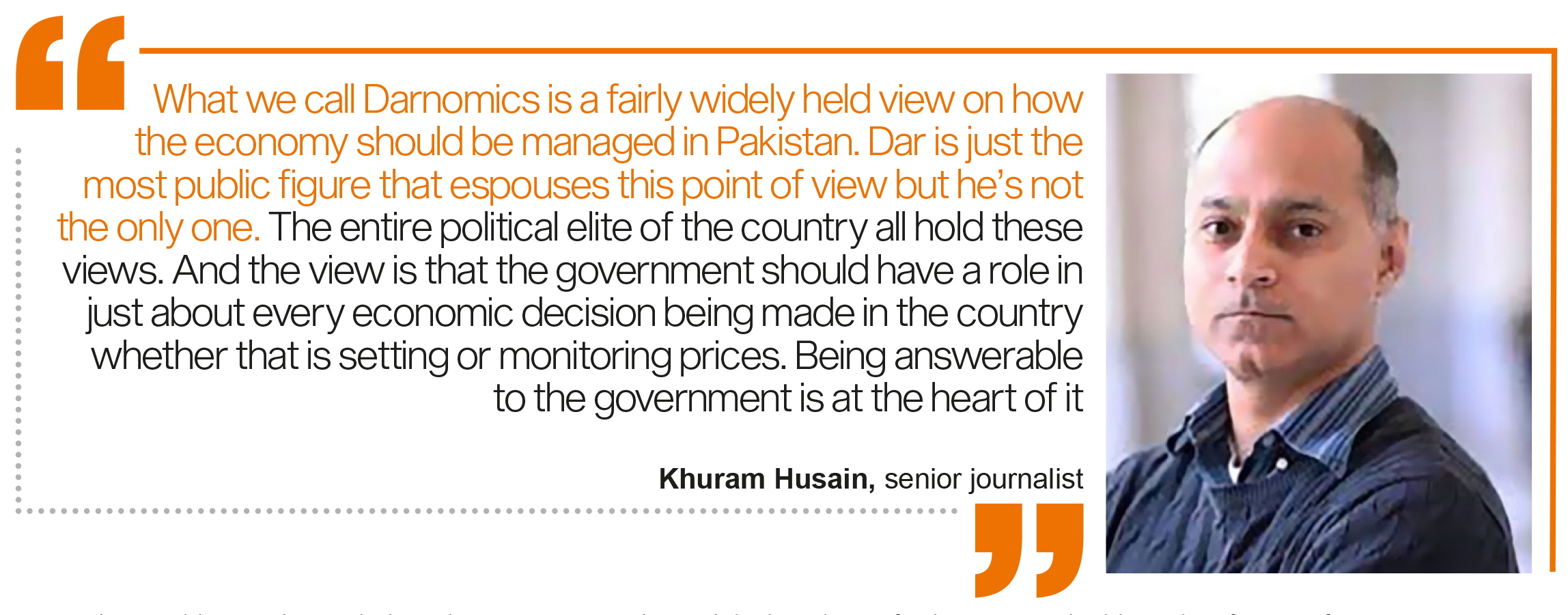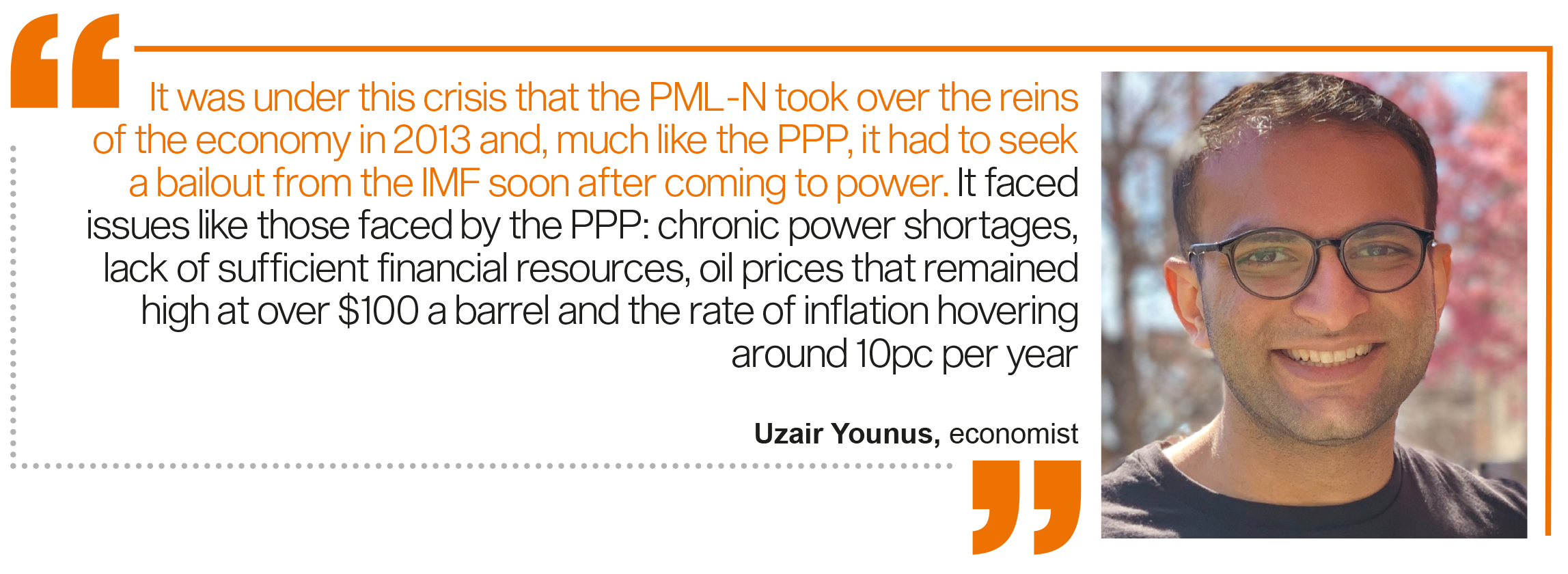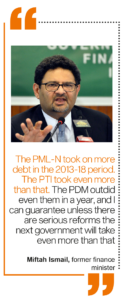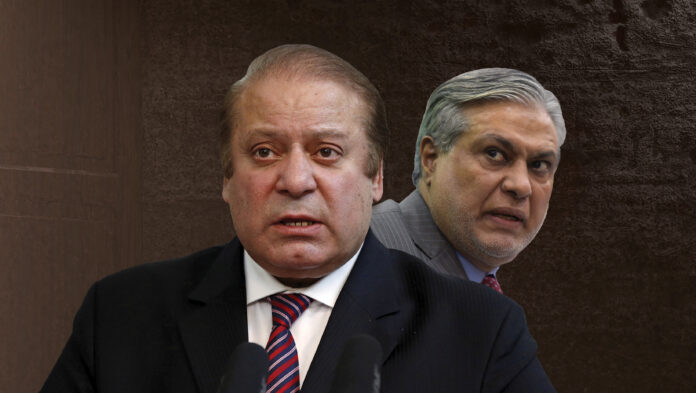There was some sense of trepidation heading into the 2013 elections. The country was at a point of economic implosion. The PPP government was leaving behind a huge crisis in terms of swelling domestic debt, the energy crisis had crippled major export oriented industries, and a new political force in the shape of the PTI was emerging to challenge Pakistan’s political status quo.
Who would take Pakistan out of this crisis? At the time, Mian Nawaz Sharif claimed he was the man for the job. The Sharif Patriarch claimed to have experience in government and a proven track record as an efficient administrator, promising to provide business-friendly economic policies and solutions to the country’s energy crisis. The economy-first approach worked and the league rode into power on the back of a massive majority and established governments in Punjab and Balochistan as well as the centre.
More than a decade later Mian Nawaz and his party stand at a similar crossroads. Inflation is hitting record highs, reserves are in the dumps, exports have fallen, and the value of the rupee is at its lowest in history. The former three-time prime minister claims he is the man for the job once again. But the country he aims to govern is starkly different from the one he took over in 2013 and left in 2019.
For starters, he does not have the popular support he once did. The way his legal problems have fallen like dominos makes it seem like he has once again cosied up with the corridors of power. His messaging has been mixed, focusing less on the country’s grave issues and more on his own personal grievances. Vengeful and uninterested in grassroots politics, the one thing Mian Nawaz is still trying to capitalise on is his supposed reputation as an economic administrator.
The reality is not so simple. The PML-N continues to claim that their time in government was a golden period for Pakistan economically — an era that can be repeated if Mr Sharif is brought back to power. Economists, politicians, and experts are all in agreement however. The 2013-18 government was neither better nor worse than previous or future ones. It was very much business as usual except on a number of issues the League got incredibly lucky. To understand this, Profit zooms in on Pakistan’s economy from 2013-18.
So who wants to be finance minister?
You’ve got to hand it to the PML-N, at least they know who their finance minister is going to be. Ishaq Dar has held the office of finance minister four times in his political career, making him the most prolific holder of what some consider the second most important role in the federal government. And it is no secret that if the Pakistan Muslim League-Nawaz (PML-N) manages to form a government after the elections on the 8th of February, he is slated to take charge of Q-block for a record fifth stint.
Compare that with the two other major parties in the country. Both the PPP and the PTI have a distinct lack of economic leadership. Look at it this way. After the 2008 elections when the PPP came to power they first formed a government with the PML-N as a coalition partner. Even in this scenario the League insisted on having Ishaq Dar as finance minister. When the PML-N split away and sat on the opposition benches, the PPP propped up Naveed Qamar as a finance guru which ended up being an experiment that didn’t last a year. Eventually, the PPP appointed the non-political Abdul Hafeez Sheikh as finance minister and then Shaukat Tarin to follow him.
The PTI is not much better in how uninspired their economic leadership has been. Imran Khan’s party had for a long time touted Asad Umar, the former CEO of Engro, as their finance whizz. While Mr Umar took office immediately after the PTI came to power, this was also a disastrous experiment. Not only did he end up resigning, the PTI also decided to go the route of appointing non-political finance ministers. And as we now know, the lack of creativity was so strong that they also picked Abdul Hafeez Sheikh and Shuakat Tarin as finance ministers.
In this regard the PML-N is at least ahead of their competitors. Say what you will about Ishaq Dar, at least his party knows who their finance guy is. The senator might be a confounding man, but you know exactly what his role in the PML-N is. Except even within the PML-N he is difficult to categorise.
His political party by all accounts is a centre-right political party with a conservative, business-friendly, strictly capitalist fiscal ideology. Yet despite these credentials he is also incredibly statist in his management of the economy. Senator Dar believes it is for the government to not just manage but micromanage the economy.
In this approach he has found many detractors including from within the PML-N. But that doesn’t seem to have made a difference. Economists and free market proponents might abhor his disciplinarian inclinations, but as party insiders have told Profit, Mr Dar holds sway where it really matters.
The Dar approach
In 2013, Pakistan was facing a serious debt problem. The previous PPP government had been on a liberal but necessary borrowing spree. Government debt had increased from Rs 6.44 trillion to Rs 15.1 trillion. This was a 135% increase in a five year period. As a percentage of the GDP, government debt had increased from 62.8% to 67.2%.
It was a crisis that the PML-N walked into. To this day they seem to feel they did a good job. And it was in this 2013-17 period that the term Darnomics actually took root. But what exactly does this mean?
“What we call Darnomics is a fairly widely held view on how the economy should be managed in Pakistan. Dar is just the most public figure that espouses this point of view but he’s not the only one. The entire political elite of the country all hold these views. And the view is that the government should have a role in just about every economic decision being made in the country whether that is setting or monitoring prices. Being answerable to the government is at the heart of it,” explains senior analyst Khuram Husain.

Darnomics is essentially a top-down approach where those in power feel that the free market is not quite trustworthy and believe the government should interfere at all points possible to ensure efficiency. This was the approach that Dar brought to the job.
“It was under this crisis that the PML-N took over the reins of the economy in 2013 and, much like the PPP, it had to seek a bailout from the IMF soon after coming to power,” writes economist Uzair Younus in an earlier article for Dawn. “It faced issues like those faced by the PPP: chronic power shortages, lack of sufficient financial resources, oil prices that remained high at over $100 a barrel and the rate of inflation hovering around 10pc per year.”

But there was also a lot for Dar and the League to work with. “The silver lining was that the PPP’s borrowing policy relied more on domestic than external borrowing. Much of this had to do with the prevalent economic conditions around the world, where the Great Recession significantly reduced the ability of economies like Pakistan to borrow money from the international bond market. This meant that the total government external debt increased by only 22pc between 2008 to 2013, going from $42.8 billion to $52.4 billion,” Younus writes in an earlier article.
This would mean that with the right mix of borrowing and spending, Pakistan’s reserves could rise, inflation could fall, and exports could increase. Dar’s immediate priority became securing loans from multiple bilateral partners. The last time Pakistan had been in such a predicament was the 2002 economic crisis when General Musharaf had just taken over. Back then, however, Pakistan had generous offers of debt restructuring from the Paris Club and a steady flow of military aid coming in from the US thanks to the war on terror. The PML-N had to rely on countries like Saudi Arabia, China, rather than on aid and institutions like the World Bank or the ADB.
At the same time, Dar also went on a crusade to try and control all aspects of the economy. Perhaps one of his least popular decisions among many was a withholding tax on withdrawal of cash from bank accounts. It led to a crisis of deposits, and the percentage of total deposits declined from 27.6% to 25% right after it was introduced.
Pakistan was in a serious balance of payments crisis in 2009 when the current account deficit was as high as 5.5% of the GDP. But the PML-N was fortunate to get Generalised Scheme of Preferences Plus status in 2013 and managed to bring down the trade and current account deficits. All of this managed to help the PML-N in stabilising the economy to a great extent. Just look at the indicators. From 2013 to 2017 Pakistan’s foreign exchange reserves rose from $6 billion to $16.2 billion. The FBR was also given a lot of power which resulted in the tax to GDP ratio rising from 8.7% to 10.5%.
Just a stroke of luck?
One thing is very clear. The PML-N promised growth and they delivered it by and large. Inflation was on average 12% between 2008-13. By Dar’s four year mark in 2017 it had dropped to around 5% while the volume of Pakistan’s economy surpassed $300 billion. On top of this energy reforms had been very seriously undertaken.
In 2013 the country faced a power deficit of 5,500MW and its industrial and urban sectors were facing 12 hours load shedding, while the rural areas faced 14 hours power outage leading to low industrial output, higher unemployment and loss of economic growth.
The PML-N government changed the strategy in 2014 by improving cash flows, optimising generation, having predictable load management, better customer service and investment facilitation. It led to record high recoveries of Rs 51b or 93.40 per cent; highest in past 10 years. The transmission and distribution losses were cut down to 10b, or 18 percent; the lowest in the past 10 years. The circular debt had also been effectively capped.
By 2018,10,000 MW of additional electricity had become part of the national grid. The government also spent lavishly on infrastructure, work was in progress on 13 motorway projects in the first few years of this government. In 2013 the length of the motorway in the country was 580 km, and by 2018 it would be extended to 1800 km. The resulting economic activity from this also helped with inflation and unemployment.
But what was the trick to this growth? Ask the experts and they will tell you a lot of it was pure dumb luck. “Two things, however, worked greatly in its favour later: by 2015, international oil prices had fallen dramatically, going below $50 a barrel. Secondly, at that time, the world was awash in liquidity as record-low interest rates and quantitative easing (essentially the printing of money) in the US, Europe and Japan led to a reach for yield in the international bond market. This meant that countries like Pakistan could borrow money at low interest rates,” explains Uzair Younus.
And since Pakistan was planning on building a lot of mega infrastructure projects, the low interest rates were greatly beneficial for Pakistan. “The league definitely got lucky. The year 2014 is when oil prices plummeted after going to record highs in late 2007 well over $100 a barrel. These guys reaped that bonanza. Energy importers are a big component. And this was also the time when China went all in on the belt and road initiative which had nothing to do with the Pakistani government of the time,” Khuram Husain tells Profit.
The flip side
Of course, there is a flip side to all of this. The growth and infrastructure development that the PML-N have made a cornerstone of their messaging for this election as well was all built on a lie. You see Pakistan in the 2013-17 period had a golden opportunity. Interest rates were low, the price of oil was in the dumps, and there was an opportunity to stabilise the economy once and for all.
Helped by low international oil prices and boosted by the start of work on the $56bn China Pakistan Economic Corridor (CPEC), economic growth stood at close to 6% its highest level in 13 years, taking the gross domestic product to an estimated $297bn this year. The only problem was that instead of consolidating at this time, Dar and the PML-N focused on growing the economy through a consumption led approach. It was the same thing that happened in the Musharaf era and it is the same thing that has happened time and again in Pakistan’s economic history.
Most of the growth was led by government spending on development projects, which raised problems of long-term sustainability. Pakistani exports dropped from $25bn in 2013 to $22bn in 2017, according to central bank data, stretching Pakistan’s foreign exchange reserves and putting further stress on the country’s current account deficit.
By the time Nawaz Sharif was ousted by a judicial order in 2017 and Shahid Khaqan Abbasi and Miftah Ismail took over, the chickens were coming home to roost. Inflation was rising and the government needed to borrow more money to pay back its debt. From July to October of 2017 alone, the federal government has obtained $2.3 billion in foreign loans, including $1.02 billion in commercial loans. The country’s official foreign currency reserves, which peaked to $19 billion, slid on the back of foreign borrowings to $13.54 billion as of November 17, barely enough to finance two-and-a-half months of imports.
A big reason for this was Dar’s insistence on pumping the market with dollars to keep the value of the rupee high. This of course caused the economy to start becoming a bubble. Because the rupee was overvalued, people went crazy on importing and the consumption led growth continued leading to a classic case of overheating. The only recourse was going to be a sudden correction, decrease in imports, a slowdown in economic activity and eventually an implosion.
“The bilateral debt increased during Noon’s time but that is because we need to make many payments and give a lot of interest. There are deficits that need to be completed through that. Ever since the NFC awards, this was always going to be the case. The PML-N took on more debt in the 2013-18 period. The PTI took even more than that. The PDM outdid even them in a year, and I can guarantee unless there are serious reforms the next government will take even more than that,” explains former finance minister Miftah Ismail, who was at the helm of affairs at the tail end of the PML-N government of that period.

“During the early years the PML-N did get lucky but the luck could have been anybody’s. The important thing then and the important thing now are reforms. Pakistan’s entire system of governance and economic management is broken. Its very foundations are weak and crumbling. That means making sure we make moves that we can realistically implement and cut down on our spending.”
He is pointing of course towards the same old issue of consumption led growth and its eventual consequences. During the 2013-17 period, there could have been much done. As Khuram Husain points out, just the issue of circular debt could have been nipped in the bud by focusing on stopping losses and reforming DISCOs. Instead, they set up more power plants and built highways that were going to be of very little use. “There was no need for superhighways for example. That money could be spent on a lot of other things but what they did build was unnecessary. Urban transit is one thing but these highways are absolutely something else.”
Nothing new nothing different
The PML-N’s economic management from 2013-18 is not the flex they might want most to think. While they might have some numbers to show in terms of growth, the reality remains that this period was more than anything else an opportunity squandered.
In fact, the 2013-18 period is quite indicative of how Pakistan’s economy runs from election cycle to election cycle. A newly elected government comes in and realises that the economy is in a bigger fix than they initially thought and their predecessors had not quite communicated just how bad things had gotten. They very quickly have to rely on borrowing from whatever sources they can find to bolster the economy. Very soon they start worrying about their popularity and unrest leading them to focus on consumption led growth which props the economy up temporarily and gets them numbers they can flash at voters. It is the equivalent of a doctor pumping a patient full of steroids to get them on their feet hoping the patient’s family won’t fire the doctor.
It is what happened with the PPP in 2008 when they took over the mess Musharaf had made. Nawaz Sharif faced a similar crisis in 2013 and left a worse one for Imran Khan in 2018. Khan’s stubbornness eventually meant the PDM received an even bigger mess. And when Shehbaz Sharif started dragging his feet and being painfully indecisive, it was clear that the PDM did an epic botch-job in record time.
Perhaps the only difference in the League’s management was that they were better at managing this consumption led growth that will be bad in the long-run. And by those standards, you might has well have Shaukat Aziz running the economy again.
What is worse is that if the League comes into power again, one can expect more of the same particularly with Ishaq Dar in charge. One former finance minister who spoke to Profit on the condition of anonymity said that on some matters Dar would even override Nawaz Sharif on matters of the economy. “Sharif himself was very pro market and wanted to float the dollar as far as we know. Dar was the one that was not and he was essentially running the economy. He stopped rebates, and gave the FBR a lot of authority. The worst part was buying dollars and selling in the market. In the last 11 months he threw so many dollars in the market it was criminal. Everything else was ok but doing this to sustain the current deficit was wrong.”
And that is the crux of the matter.


























Nawaz Sharif Claim is true he can save Pakistan economy with his skills.
No.
Boot polishing can do wonders it can even make one a prime minister despite being indicted. So moral of the story is polish the boots of military often and do it well.
We’re a group of volunteers and starting a new scheme in our community. Your web site offered us with valuable info to work on. You’ve done a formidable job and our entire community will be grateful to you.
One one can polish boots better than niazi Bhai himself. The way he took a ride into power in 2018 has been well debated.
Niazi Bhai’s tenure had largely failed to deliver on its promises.
high debt borrowings
dollar shooting from 100 to 180
no such good economic growth etc
Btw we all know the indication are just establishment’s games weather it was Nawaz sharif yesterday or Imran Khan today.
Tomorrow after 3 years or maybe even earlier when the economy will be fixed again he will be out again and with establishment another pm will be ousted and the cycle repeats itself again…..
Thanks for the sharing.